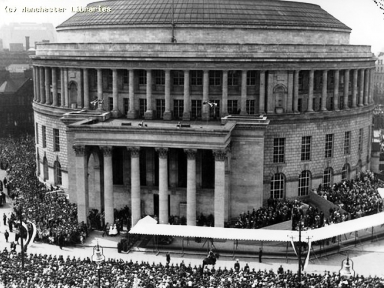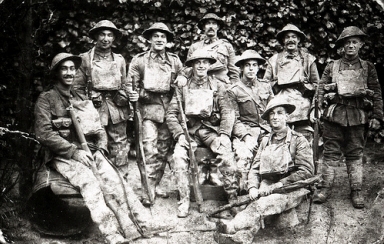I am the Opening Up Archives trainee at the Greater Manchester County Record Office. Working here has been a particularly interesting trip down my own Memory Lane. I was part of a team who collected family photographs and recorded oral history interviews relating to Manchester back in the early 1980s, and unexpectedly I have been able to revisit some of that material here. I am part of the Archives + team, a partnership of local archives who are joining forces and moving back into the newly refurbished Central Library in Spring 2014.
Work on exhibitions and the new Archives+ website means that my research all those years ago has taken on a new relevance. It’s a strange experience to listen to the old reel-to-reel tapes and see my handwritten notes from those pre-computer days.
It’s exciting seeing the final stages of this major project to refurbish the iconic Central Library building, the future home of archives and local studies in Manchester.
It’s also been an unusual time to be part of a public archive, as we have had to close to the public for six months. This means we have been using our online collections and social media to connect with the public. Facebook, twitter and flickr have all been playing their part, as well as the new website and our blogs.
I have borrowed the title of Joan Littlewood’s 1963 stage musical about World War One for this post. The centenary of the Great War is to be commemorated this year. There will be many and varied World War One related events from a host of galleries, museums, archives and collections. The family photo collection project I worked with back in the 1980s brought in literally thousands of photos on a wide and random range of subjects. Back then many people kept photos in shoe boxes under the bed or on top of the wardrobe. Some were more organised and had them in albums. Contacts were made through talks, exhibitions, local newspaper appeals, word of mouth and recommendation. It was part of a movement that recognised that personal life experiences were as important as formal history books in building up a picture of the past. Sometimes photos accompanied taped interviews. Notes were taken, photos were borrowed and then photographed and the archive that is now known as the Documentary Photographic Archive was born. Originals went back to the people who had donated them. Negatives and contact prints were given identifying numbers, cross referenced with the donors and their information.
Many of these images have now been digitised, and are available on the Manchester Archives Flickr photostream. In 2013 a project began to identify and digitise all the images with any connection to the First World War. Once this was done, over three thousand of them were uploaded on to flickr as our World War One set. It’s an amazing collection, not least because of the range of subjects. There are the studio photos of men in uniform, but there are also photos of men at the front, women at work, hospitals and operating theatres, camels and pyramids, sentimental and comic postcards, horses and dogs, nurses and patients. The nature of the collection means that very few of these are official or formal photos. It never fails to amaze me that these images have survived.
We are told that cameras weren’t allowed at the front. How did film survive the extremes of heat and cold, mud and sand? Then it had to be developed and printed, not a cheap or instant process. Finally someone had to save and treasure those printed photographs.
If you had photos of your lads larking about on an Egyptian beach, could you ever share them with your next door neighbour who had lost a son in France?
I have been working with volunteers to bring out some of the stories behind these photos. Volunteers have also transcribed a local hospital’s operation records relating to both British and German soldiers. A diary from June to July 1917, describing the writer’s experiences in France has also been transcribed. Sadly, the last entry is written by his brother, brothers in arms, together until the end for one of them. Another diary describes the work of a hospital orderly on a ship in the Dardanelles. Gallipoli, Sulva Bay and the sinking of the ‘Royal Edward’, all described by someone who was there.
These stories are being shared on the GM1914 blog, a project designed to bring together the Greater Manchester Archives and Local Studies Partnership collections. Each collection has had volunteers working on stories from their archives and the blog posts are providing a fantastic insight into the lives of local people at home and at war overseas.
I have learnt so much about the Great War during this project, and I am very grateful to all those who maintain websites and share their knowledge of the period. I know I will never become an expert on battles and battalions, but the human stories are so moving and sometimes so unexpected. It has been a privilege to be part of a project to share them.
Flickr World War One photostream http://www.flickr.com/search/?w=55918222@N02&q=World%20War%20One



It would be interesting to learn more about the origins of the photographs, for example dividing them between official photos taken by professionals ie army photographers and photojournalists and amateur shots taken by the soldiers themselves.
Of course, the whole of the Western Front was photographed on a surprisingly ( to us) accurate scale. Not only was aerial photography used on an intensive scale, but the enemy front was photographed from our front trench using cameras which must have been sophisticated for the time. I have a book showing these panoramas.
I suppose the amateur shots would have been taken using roll film cameras , Box Brownies, using 120 roll film or similar.
I was told by a former soldier in my own regiment who served in the second world war, that he was appointed as the regiment’s photographer on an informal basis by the C.O. after a Rolleicord camera was captured in Italy. Perhaps battalions at the front in WW1 made similar arrangements.